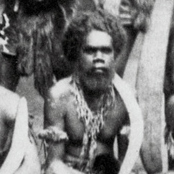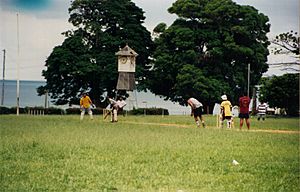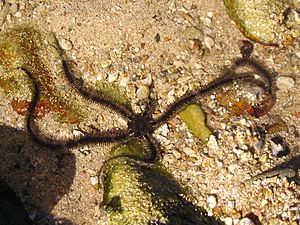Great Palm Island facts for kids
|
Bwgcolman
|
|
|---|---|
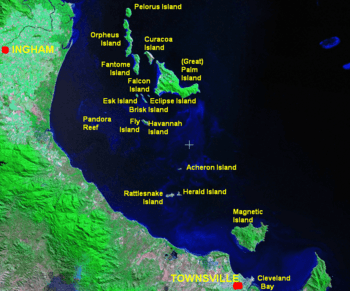
Palm Islands
|
|
| Geography | |
| Coordinates | 18°44′11″S 146°37′04″E / 18.73633°S 146.617699°E |
| Archipelago | Palm Islands, Queensland |
| Area | 55 km2 (21 sq mi) |
| Highest elevation | 548 m (1,798 ft) |
| Administration | |
|
Australia
|
|
| State | Queensland |
Great Palm Island, often called Palm Island, is the biggest island in the Palm Islands group. It's located off the coast of Northern Queensland, Australia. The island is well-known for its Aboriginal community. This community grew from a special area called the Palm Island Aboriginal Settlement, also known as "the Mission."
The original people of Palm Island were the Manbarra people. They were moved to the mainland by the Queensland Government in the 1890s. The island is also known as Bwgcolman. This name refers to the Aboriginal and Torres Strait Islander people from many different groups who were sent to the reserve starting in 1918, and their families today.
Palm Island covers about 55 square kilometres. The larger area of 70.9 square kilometres includes the Aboriginal Shire of Palm Island, which has nine smaller islands. The island is about 65 kilometres northwest of Townsville. It has small bays, sandy beaches, and tall, forested mountains. The highest point is 548 metres. The ocean around the island is part of the Great Barrier Reef Marine Park. Here, fishing and other activities are carefully managed to protect the reef.
Palm Island is the only inhabited island within the Aboriginal Shire of Palm Island. This local government area also includes nine other smaller islands in the Palm Islands group.
Contents
Exploring Palm Island's Past
Great Palm Island is often seen as a beautiful "tropical paradise." However, it has a complex history since European settlement began in Australia.
Early History and Names
We don't know what the Manbarra people called the island before Europeans arrived. The group of islands was named the "Palm Isles" by explorer James Cook in 1770. He sailed along Australia's eastern coast on his first voyage. The name "Great Palm Island" for this specific island has been used since at least 1866.
Other names for the island have included the Mission, Palm Island settlement, and Bwgcolman.
The Manbarra People
In Manbarra beliefs, the Palm Island group was created in the Dreamtime. They believe it formed from pieces of an ancestral spirit, the Rainbow Serpent. The Manbarra language is from the Palm Island region. This area is within the Palm Island Aboriginal Shire Council boundaries.
When Captain Cook visited in 1770, it's thought about 200 Manbarra people lived on the island. Cook sent some of his crew to the island, but they didn't find anything special to report. In 1819, Captain Phillip Parker King landed on one of the islands. He saw recently used circular huts and canoes.
From the 1850s, people from the island were sometimes asked to work. They would leave the island to help with bêche-de-mer (sea cucumber) and pearling businesses run by Europeans and Japanese.
By the late 1800s, the island's population had dropped to about 50 people.
The Story of Kukamunburra
There's a special burial site on Palm Island for a young Manbarra man named Kukamunburra. He was renamed "Tambo" by a circus agent in 1883. This agent worked for the famous "Barnum, Bailey and Hutchinson's Greatest show on earth." Kukamunburra and eight other Murri people were taken to tour with the circus in the United States.
Sadly, Kukamunburra died in 1884 at age 21 from pneumonia. His body was preserved. Over a hundred years later, in 1993, his body was found in a funeral home. An expert identified him, and his remains were brought back to Palm Island in 1994. He was finally buried in his homeland.
Palm Island Aboriginal Settlement
For much of the 1900s, the Queensland Government used Palm Island as a settlement for Aboriginal people. It was a type of Aboriginal reserve that also acted like a penal colony. People were sent there for various reasons, sometimes for being "disruptive" or having mixed heritage.
In 1918, a cyclone destroyed the Hull River Aboriginal Settlement on the mainland. The people living there were moved to Palm Island. This new population came from at least 57 different language groups across Queensland and the Torres Strait Islands. These people and their descendants are now known as the Bwgcolman people.
Palm Island quickly became the largest Aboriginal reserve in Queensland. It was known as a place where Indigenous people were sent as punishment. They came from all over Queensland, sometimes after being sentenced by a court or released from prison.
A bell tower was built to control daily life on the mission. The bell would ring each morning, telling everyone to line up. If you didn't, your food was cut. It rang again at night to turn off the island's electricity. This bell tower still stands today, reminding everyone of Palm Island's history.
In 1997, the Bringing Them Home Report mentioned Palm Island. It was listed as a place that housed children who were taken from their families, part of the Stolen Generation.
World War II Base
During World War II, the US Navy built an air station on Palm Island in 1943. It was used for Catalina flying boats and patrol boats. The base was built at Wallaby Point, a quiet part of the island. It had concrete ramps for the flying boats and parking areas.
By September 1943, most of the base was ready. It could repair about four aircraft each day. The US Naval Air Station was fully open by October 1943. It closed in May 1944. Today, you can still see parts of the steel rails and even some submerged plane wrecks.
The 1957 Strike
In 1957, a group of Islanders went on strike. They were protesting against the very tough working conditions. People were required to work 30 hours a week, and until the 1960s, they weren't paid for this work. The strike also protested low wages and poor housing.
As a result, armed police arrived from Townsville. The strike leaders and their families were forced to leave the island. In 2007, the Queensland Government apologized to the families of two of the strikers for what happened.
"Stolen Wages" Case
From 1985, some Aboriginal people who worked on the Palm Island reserve filed complaints. They said they were paid less than they should have been between 1975 and 1984. In 1996, a human rights commission agreed with them. They said that Aboriginal workers doing the same job were paid less.
Later, in 2019, the Queensland Government agreed to pay about $190 million to a group of 10,000 Aboriginal and Torres Strait Islander people. This was to settle a lawsuit about their "stolen wages."
The 2004 Incident and Its Aftermath
In November 2004, a Palm Island resident named Mulrunji died in a police cell. He was 36 years old. A week later, the results of his autopsy were shared with the community. This led to a riot. The local courthouse, police station, and police barracks were burned down. Police officers and their families had to hide in the hospital. Later, many police arrived from Townsville to restore order.
An investigation followed, and a coroner found that Mulrunji died from injuries caused by the arresting officer. After a long legal process, the officer was found not guilty. However, a community leader, Lex Wotton, was found guilty of encouraging the riot and was sentenced to prison.
In 2016, a court found that the police actions after the riot were unfair and went against the Racial Discrimination Act 1975. The court said the police acted this way because they were dealing with an Aboriginal community. In 2018, a large settlement of $30 million was awarded to the victims.
New Beginnings: First Indigenous Senior PSOs
On October 2, 2020, six people from Palm Island became Senior Protective Security Officers (SPSOs). They joined the Queensland Police Service. This group became the first SPSOs to provide security services for their community.
Island Geography and Nature
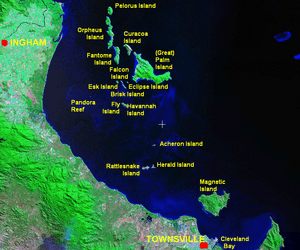
Great Palm Island is about 55 square kilometres. This makes it nearly twice the size of Norfolk Island. It's similar in size to Magnetic Island. There are sixteen islands in the Greater Palm group. Most of these are very small. The main islands are Great Palm Island, Fantome Island, and Orpheus Island.
The island's center is dominated by Mount Bentley, its tallest peak. In the southwest, there's Mount Lindsay. The island is covered by rainforest, with some areas cleared for towns and the airstrip. The Palm Island airstrip is located on a narrow flat area in the southwest.
Challenger (Gowyarowa) Bay is a body of water between Great Palm Island, Curacoa (Noogoo), and Fantome Islands. There are also several smaller bays around the island.
| Bay | Notes |
|---|---|
| Cannon (Numbullabudgee) | by Wallaby (Nullaree) Point |
| Bullumbooroo | |
| North East (Othoorakool) | |
| Barber | within view of Barber (Boodthean) Island |
| Mundy | |
| Butler (Surrumbroo) | at the southeast end of the airport |
| Pencil | |
| Casement | at the northwest end of the airport |
| Regina | |
| Coolgood | has a pier, a settled area is inland |
| Coolgaree Bay | a settled area is inland |
The island has three man-made freshwater sources. These include Bamboo Dam near Mount Bentley and Solomon Dam.
Island Environment and Wildlife
Palm Island has rich volcanic soil. This soil supports many tropical plants. You can find mangroves, eucalypt forests, rainforests, hoop pine, mango, banana, pawpaw, and wild plum trees. The waters around the island are home to diverse marine life. This includes coral trout, crayfish, and beautiful coral reefs.
However, human settlement and introduced species have affected the island. There are hundreds of wild horses on the island. In the past, there were concerns about how these animals were treated. Now, the Shire Council and the RSPCA work to care for the horses. They also teach residents, especially children, how to help. Wild dogs are also a challenge on the island.
Life on Palm Island
The local government on the island is the Palm Island Aboriginal Shire Council. This council manages ten of the islands in the Greater Palm group. It gained full Shire Council status in January 2007.
Australia Post uses one postcode for "Palm Island, QLD" (4816), which covers the entire island group.
Island Settlements
The settled areas on Palm Island don't have formal names. The main town on the west coast, near the jetty, is still called "the Mission" by some locals. This main town has government offices, schools, shops, a football club, a hospital, and churches. It also has a library called the Bwgcolman Indigenous Knowledge Centre. A new retail center opened in 2020, featuring art by local artists. This center will include a supermarket and a tourist information center.
Another settled area is at the southeast end of the airport. A third area is on Coolgaree Bay, north of the main town.
People and Community
At the 2016 census, Palm Island had 2,298 residents. Most of them (94.1%) were of Indigenous origin. Of these, 75.2% were Australian Aboriginal, and 12.8% were Torres Strait Islander.
Because people from many different parts of Queensland were sent to Palm Island, the population is a mix of Manbarra and other Aboriginal peoples. This history has led to many challenges for the community.
Economy and Jobs
The unemployment rate on Palm Island was about 51% in September 2019. In 2004, there was no industry on the island, even though it has rich natural resources like crayfish and potential for tourism. The cost of living is quite high on Palm Island because it's a remote island. For example, in 2007, a loaf of bread cost about twice as much as in other parts of Australia.
The natural environment around Palm Island is great for farming oysters, shrimp, prawns, and mackerel. In the 1970s, an oyster farm was started, but it later stopped working.
In 2020, a new $10 million retail and business center was finished. This project was mostly funded by the government. It's hoped that this center will keep more money on the island and create local jobs. There is also potential for more tourism development.
Tourism on Palm Island
Some efforts have been made to develop tourism on Great Palm Island. The island has tropical rainforests and diverse flora and fauna. It's also close to the Great Barrier Reef, making it ideal for eco-tourism.
Research in 2007 suggested that Palm Island has many resources to become self-sufficient through housing, farming, and tourism. However, the island's past negative reputation has sometimes made it harder to attract visitors.
A new tourism effort began in 2015. It included open days where tourists could visit the island. They could try traditional food and experience Indigenous culture through activities like dot painting and basket weaving workshops. The first open day was very popular, with over 200 tourists.
In April 2018, the island celebrated 100 years since the Aboriginal settlement was established. They held a three-day "Deadly Didge and Dance Festival." This event showcased local talent and pride through dance, song, and ceremony. Elders wanted to show that the island is not just a place of violence. They highlighted new opportunities for young people in education and the economy.
There are limited places for tourists to stay on Great Palm Island. These include Klub Kuda and the Palm Island Motel, which is run by the council.
Community Life and Support
Community Planning
In 1998, the Palm Island Vision Plan was created. This plan aimed to improve the well-being of Islanders, especially young people. While it had good goals, it didn't get enough support or funding at first.
In 2000, a Community Renewal Plan started. It focused on improving things for young people, building self-esteem, and creating jobs. As part of this, a youth and community center was built. Technology centers were also set up in schools.
In 2005, another report, Palm Island: Future Directions, was created. It said that the Palm Island community and the Queensland and Federal Governments needed to work together. It recognized that the island's problems came from past events and lack of funding. The report suggested that the government should provide more resources and encourage private investment.
Law and Order
Alcohol restrictions are in place on Palm Island. Since June 2006, the ten islands in the Palm Island Aboriginal Shire Council have become a restricted area for alcohol. This means there are limits on how much alcohol a person can bring onto the island. The only place to buy alcohol on the islands is the Coolgaree Bay Sports Bar and Bistro, and you need a membership to buy from there.
Culture and Sports
Many residents feel that the introduction of Western culture and past mission policies have weakened traditional Australian Aboriginal culture on Palm Island.
Boxing is a very popular sport on Palm Island for both men and women. In 2006, 11 young Palm Islanders represented Queensland at national boxing championships. The Barracudas are the local rugby league team. In June 2005, a 3-on-3 Basketball competition was held, attracting over 300 locals.
Many sports activities are supported by the Queensland Police Citizens Youth Welfare Association facility. This is the Palm Island Community and Youth Centre (PICYC). The center opened in 2005. It is now a very positive place for youth and community engagement through sport and education. Adults and youth use the facility a lot. It has a gym for boxing, and facilities for aerobics, dancing, indoor volleyball, and soccer.
The PICYC is considered a great success. It is mostly staffed by community members. They teach younger generations traditional and life skills like weaving and cooking. The center also hosts community projects, like a radio service (Bwgcolman Radio), an Internet Café, and cooking classes.
On January 10, 2018, the Queen's Baton Relay for the Commonwealth Games visited Palm Island for the first time. This was a special event for the community.
Island Facilities
In 2004, the army completed $10 million worth of work on the island. They built a permanent water-supply dam and improved several roads.
Palm Island Airport is located on the southwest of the island. Palm Island's pier is in Challenger Bay. A ferry service travels to and from Townsville. A barge service also operates from Townsville, bringing food, machinery, and fuel to the island.
The Aboriginal Shire of Palm Island runs the Bwgcolman Indigenous Knowledge Centre. This library is on Main Street on Great Palm Island. The Queensland Government has also set aside $3 million for a splash park to provide safe swimming.
Education on Palm Island
Palm Island has good education facilities for its size. There are both State and private primary schools. Secondary education is offered up to year twelve on the island. There is also a campus of the Barrier Reef Institute of TAFE (technical and further education). Some students choose to live on the mainland to attend private schools.
The island has two schools: St Michael's Catholic School (for Prep to Grade 7) and the Education Queensland Bwgcolman Community School (for Prep to Grade 12). The Bwgcolman Community School also has a library.
The Bwgcolman Community School has 350 students and many staff members. Like most Aboriginal communities, Palm Island faces challenges with school attendance. The Principal of St. Michael's has said that about 30% of their 160 students are absent on average. St Michael's teaches students "dainty" (standard Australian English) as a third language. This is in addition to the commonly spoken "Island English" and the child's specific language group.
Images for kids
See also
 In Spanish: Isla Gran Palmera para niños
In Spanish: Isla Gran Palmera para niños


